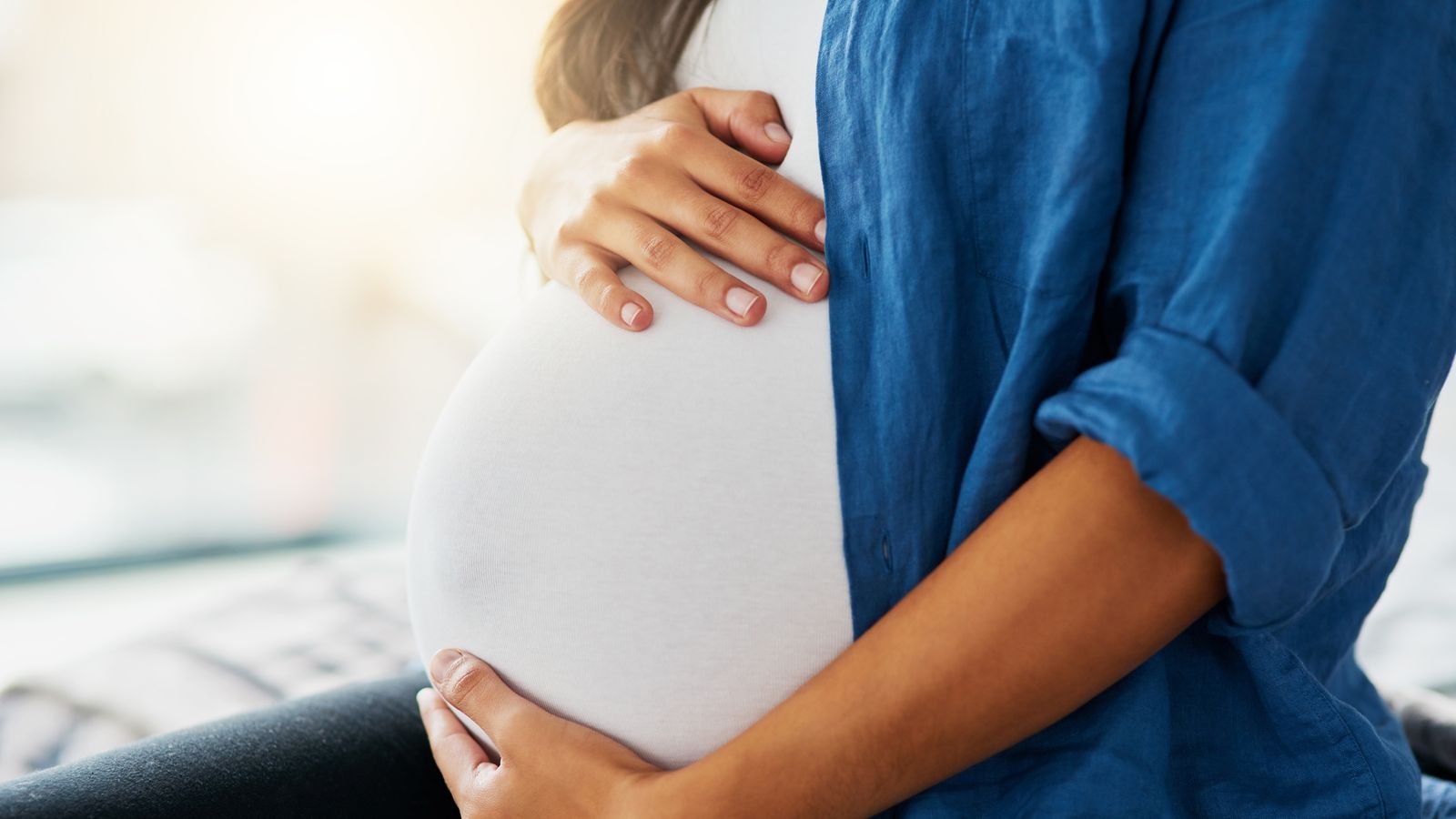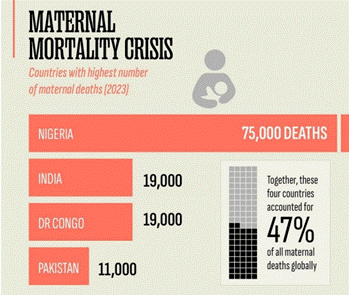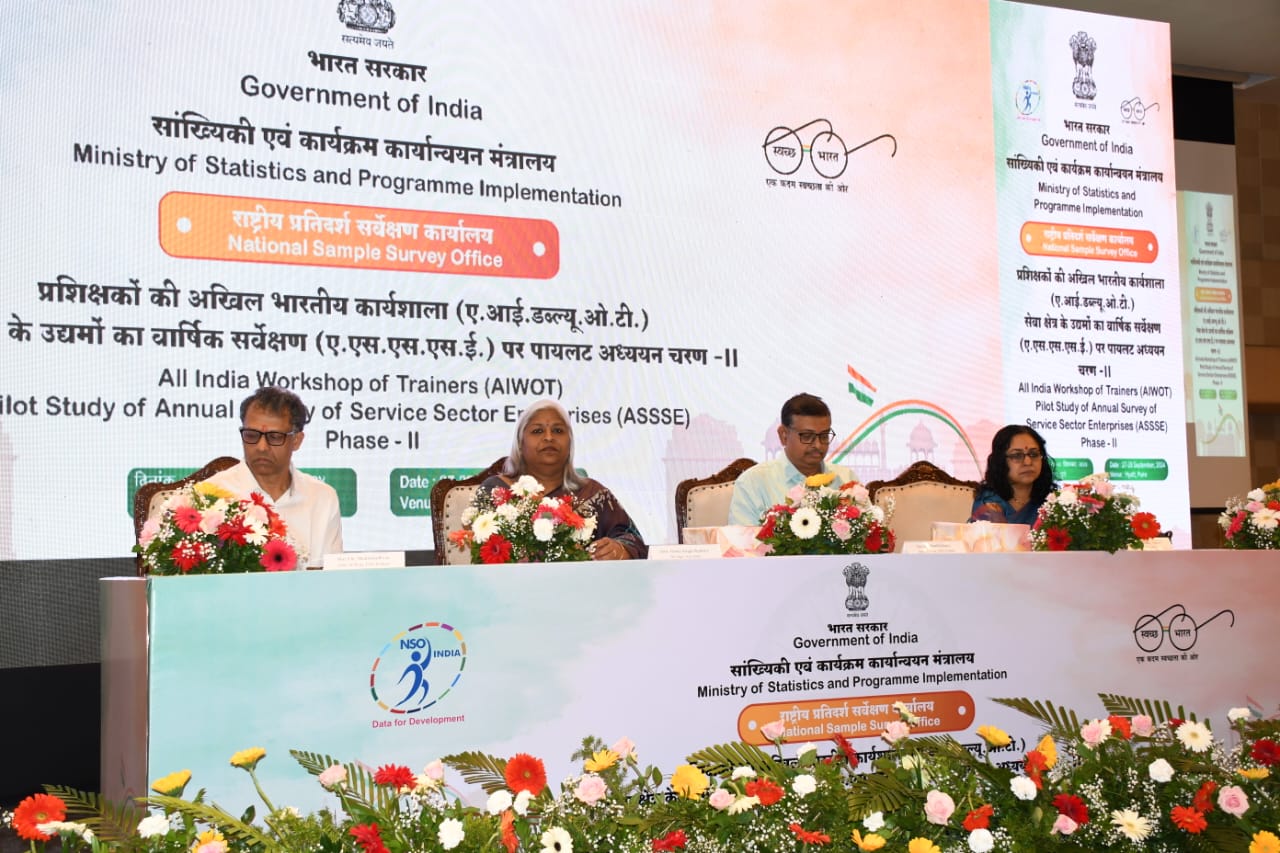- Courses
- GS Full Course 1 Year
- GS Full Course 2 Year
- GS Full Course 3 Year
- GS Full Course Till Selection
- CSAT
- 5 LAYERED ARJUNA Mentorship
- Public Administration Optional
- Online Program
- GS Recorded Course
- NCERT (Recorded 500+ Hours)
- Polity Recorded Course
- Geography Recorded Course
- Economy Recorded Course
- AMAC Recorded Course
- Modern India, Post Independence & World History
- Environment Recoded Course
- Governance Recoded Course
- Science & Tech. Recoded Course
- International Relations and Internal Security Recorded Course
- Disaster Management Module Course
- Ethics Recoded Course
- Essay Recoded Course
- Current Affairs Recoded Course
- ABOUT US
- OUR TOPPERS
- TEST SERIES
- FREE STUDY MATERIAL
- VIDEOS
- CONTACT US
India saw 52 maternal deaths each day in 2023, 2nd highest after Nigeria—UN report
India saw 52 maternal deaths each day in 2023, 2nd highest after Nigeria—UN report

- In 2023, India faced 19,000 maternal deaths, meaning 52 women died every day due to complications related to pregnancy or childbirth.
- This was 2nd highest globally, tied with the Democratic Republic of Congo (DRC), after Nigeria, according to the Trends in Maternal Mortality 2000-2023 report released in April 2025.

Trends in Maternal Mortality 2000-2023 Report Prepared By:
- The report was prepared by several important international organizations:
- World Health Organisation (WHO)
- UNICEF
- UN Population Fund (UNFPA)
- World Bank
- UN Department of Economic and Social Affairs (Population Division)
- These organizations worked together to collect and analyze data related to maternal mortality around the world.
Purpose of the Report:
- The report provides global data on maternal mortality and highlights the countries with the highest rates of maternal deaths.
- It also shows the trends over the years, such as how the numbers have changed since 2000.
Key Definitions:
- Maternal Mortality: This refers to the death of a woman during pregnancy, childbirth, or within 42 days after delivery. The cause must be related to complications from pregnancy or childbirth.
- Maternal Mortality Ratio (MMR): MMR is the number of maternal deaths per 100,000 live births in a specific time period, usually measured annually.
- This ratio helps to understand how dangerous childbirth is in different countries and regions.
Key Statistics (2023) :
|
Country |
Maternal Deaths |
Global Share |
|
Nigeria |
75,000 |
28.7% |
|
India |
19,000 |
7.2% |
|
DRC |
19,000 |
7.2% |
|
Pakistan |
11,000 |
4.1% |
|
China |
1,400 |
Less than 1% |
China, despite having a population similar to India, recorded only 1,400 maternal deaths.
These 4 countries (Nigeria, India, DRC, and Pakistan) together accounted for 47% of all maternal deaths globally in 2023.
India’s Progress: Reducing Maternal Mortality :
- Declining Maternal Mortality Ratio (MMR):
- In 2000, India’s MMR was 362 deaths per 100,000 live births.
- By 2023, this decreased to 80 deaths per 100,000 live births, reflecting a 78% reduction over 23 years.
- This marks significant progress, though the rate of improvement has slowed in recent years.
- Institutional Deliveries:
- Institutional deliveries (births in healthcare facilities) increased from 79% in 2015-16 to 89% in 2019-21.
- States like Kerala achieved 100% institutional deliveries.
- State-Level Progress:
- Eight Indian states (Kerala, Maharashtra, Tamil Nadu, Telangana, etc.) have reduced their MMR to below the Sustainable Development Goal (SDG) target of 70 maternal deaths per 100,000 live births.
Key Causes of Maternal Deaths
- Direct Causes (responsible for most maternal deaths):
- Post-partum hemorrhage (PPH): Excessive bleeding after childbirth. This is the leading cause of maternal death globally.
- Hypertensive disorders: High blood pressure conditions, such as pre-eclampsia, which can complicate pregnancy.
- Infections: Bacterial or viral infections occurring during pregnancy, childbirth, or postpartum.
- Unsafe abortions: Abortions performed under unsafe conditions, which can lead to maternal death.
- Indirect Causes:
- Chronic diseases: Pre-existing conditions such as diabetes, asthma, and heart disease can complicate pregnancies and lead to maternal deaths.
- Mental health issues: Disorders like depression, anxiety, and substance abuse, which affect maternal health.
- Maternal infectious diseases: Conditions like malaria, HIV/AIDS, and tuberculosis can significantly affect pregnancy outcomes.
- Preventability:
- Most of these causes are preventable with proper healthcare, skilled birth attendants, and emergency obstetric care.
Why Is India Still Struggling with Maternal Deaths?
Despite improvements, there are still substantial challenges:
- Primary Health Centers (PHCs) and Community Health Centers (CHCs): These centers can manage normal deliveries but are often ill-equipped to handle complicated pregnancies, leading to referrals or delays.
- Geographical and Socioeconomic Disparities:
- Southern states like Kerala, Tamil Nadu, and Maharashtra have better healthcare systems and have seen significant improvements in maternal health.
- Northern states like Uttar Pradesh and Bihar still struggle with poorer healthcare infrastructure, leading to higher maternal death rates.
- Inadequate Emergency Obstetric Care: Rural areas and remote regions lack access to emergency care, skilled doctors, and necessary equipment, which contributes to high maternal mortality.
The Impact of COVID-19
- COVID-19 and Maternal Health in 2021:
- During the COVID-19 second wave in 2021, an additional 40,000 women died due to pregnancy-related complications.
- The rise in maternal deaths was caused by:
- Direct effects of COVID-19 on pregnant women, such as respiratory complications.
- Healthcare disruptions: Maternity wards closing, staff shortages, and lack of essential medicines.
- Lesson from COVID-19:
- Maternity services must continue during pandemics and emergencies to ensure safe pregnancies and deliveries.
Solutions and Action Required
- Improved Healthcare Access: Emergency obstetric care and skilled birth attendants need to be made available in rural and remote areas.
- Training Healthcare Workers: Increase the number of trained professionals to handle complicated pregnancies and emergency obstetric care.
- Public Awareness and Education: Educating communities, especially in rural areas, about the importance of prenatal care, family planning, and seeking timely medical help.
- Infrastructure and Resources: Improving the infrastructure and resource availability at PHCs and CHCs for the effective management of complicated cases.
Various Schemes for Maternal Health in India:
|
Scheme Name |
Launched |
Objective |
Notable Features |
Target Beneficiaries |
|
Janani Suraksha Yojana (JSY) |
2005 |
Promote institutional deliveries and reduce maternal mortality |
Cash incentives, Focus on rural areas |
Pregnant women from poor socio-economic backgrounds |
|
Pradhan Mantri Matru Vandana Yojana (PMMVY) |
2017 |
Provide maternity benefits and encourage institutional deliveries |
₹5,000 cash benefit for first child, Incentives for girl child |
Women pregnant with their first child after 01.01.2017 |
|
Janani Shishu Suraksha Karyakaram (JSSK) |
2011 |
Eliminate out-of-pocket expenses for pregnant women and sick infants |
Free delivery services, Free transport, Free post-delivery services |
Pregnant women and sick infants in public health institutions |
|
Surakshit Matritva Aashwasan (SUMAN) |
2019 |
Provide assured, dignified, and quality healthcare at no cost |
Zero denial policy, Focus on quality care, Respectful care |
All pregnant women and newborns visiting public health institutions |
|
LaQshya |
2017 |
Improve the quality of care in labor rooms and maternity OT |
Improve infrastructure, Monitoring and evaluation, Quality assurance |
Pregnant women in labor rooms and maternity OT |
|
Also Read |
|
| Public Administration Optional | |
| UPSC Monthly Magazine | Question Answer Practice For UPSC |




